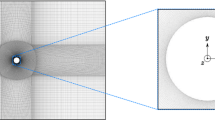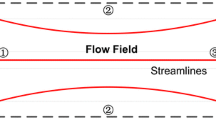Abstract
This work presents, compares and discusses results obtained with two indirect methods for the calculation of aerodynamic forces and pitching moment from 2D Particle Image Velocimetry (PIV) measurements. Both methodologies are based on the formulations of the momentum balance: the integral Navier–Stokes equations and the “flux equation” proposed by Noca et al. (J Fluids Struct 13(5):551–578, 1999), which has been extended to the computation of moments. The indirect methods are applied to spatio-temporal data for different separated flows around a plate with a \(16\mathrm {:}1\) chord-to-thickness ratio. Experimental data are obtained in a water channel for both a plate undergoing a large amplitude imposed pitching motion and a static plate at high angle of attack. In addition to PIV data, direct measurements of aerodynamic loads are carried out to assess the quality of the indirect calculations. It is found that indirect methods are able to compute the mean and the temporal evolution of the loads for two-dimensional flows with a reasonable accuracy. Nonetheless, both methodologies are noise sensitive, and the parameters impacting the computation should thus be chosen carefully. It is also shown that results can be improved through the use of dynamic mode decomposition (DMD) as a pre-processing step.









Similar content being viewed by others
References
Adrian RJ (1991) Particle-imaging techniques for experimental fluid mechanics. Ann Rev Fluid Mech 23(1):261–304
Albrecht T, del Campo V, Weier T, Gerbeth G (2012) Comparison of PIV-based methods for airfoil loads evaluation. In: 16th International Symposium on Applications of Laser Techniques to Fluid Mechanics, Lisbon, Portugal, July, vol 9, p 12
Albrecht T, del Campo V, Weier T, Metzkes H, Stiller J (2013) Deriving forces from 2D velocity field measurements. Eur Phys J Spec Top 220(1):91–100
Barlow JB, Rae WH, Pope A (1999) Low-speed wind tunnel testing. Wiley
Charonko JJ, King CV, Smith BL, Vlachos PP (2010) Assessment of pressure field calculations from particle image velocimetry measurements. Measurement Sci Technol 21(10):105,401
Dabiri JO, Bose S, Gemmell BJ, Colin SP, Costello JH (2014) An algorithm to estimate unsteady and quasi-steady pressure fields from velocity field measurements. J Exp Biol JEB 092,767
David L, Jardin T, Farcy A (2009) On the non-intrusive evaluation of fluid forces with the momentum equation approach. Measurement Sci Technol 20(9):095,401
Fage A, Johansen FC (1927) On the flow of air behind an inclined flat plate of infinite span. Proc R Soc Lond Ser A 116:170–197
Gardner AD, Klein C, Sachs WE, Henne U, Mai H, Richter K (2014) Investigation of three-dimensional dynamic stall on an airfoil using fast-response pressure-sensitive paint. Exp Fluids 55(9):1807
Gharali K, Johnson DA (2014) PIV-based load investigation in dynamic stall for different reduced frequencies. Exp Fluids 55(8):1803.
Godoy-Diana R, Aider JL, Wesfreid JE (2008) Transitions in the wake of a flapping foil. Phys Rev E 77(1):016,308
Graftieaux L, Michard M, Grosjean N (2001) Combining PIV, POD and vortex identification algorithms for the study of unsteady turbulent swirling flows. Measurement Sci Technol 12(9):1422
Granlund KO, Ol MV, Bernal LP (2013) Unsteady pitching flat plates. Journal of Fluid Mechanics 733
Gurka R, Liberzon A, Hefetz D, Rubinstein D, Shavit U (1999) Computation of pressure distribution using PIV velocity data. In: Workshop on particle image velocimetry, vol 2
Jardin T, Chatellier L, Farcy A, David L (2009) Correlation between vortex structures and unsteady loads for flapping motion in hover. Exp Fluids 47(4–5):655
Jones BM (1936) The measurement of profile drag by the pitot-traverse method. HM Stationery Office
Kurtulus DF, Scarano F, David L (2007) Unsteady aerodynamic forces estimation on a square cylinder by TR-PIV. Exp Fluids 42(2):185–196
Lam KM, Leung MYH (2005) Asymmetric vortex shedding flow past an inclined flat plate at high incidence. Eur J Mech B Fluids 24(1):33–48
Laskari A, de Kat Rd, Ganapathisubramani B (2016) Full-field pressure from snapshot and time-resolved volumetric PIV. Exp Fluids 57(3):44
Lin JC, Rockwell D (1996) Force identification by vorticity fields: techniques based on flow imaging. J Fluids Struct 10(6):663–668
McLachlan BG, Bell JH (1995) Pressure-sensitive paint in aerodynamic testing. Exp Therm Fluid Sci 10(4):470–485
Noca F, Shiels D, Jeon D (1997) Measuring instantaneous fluid dynamic forces on bodies, using only velocity fields and their derivatives. J Fluids Struct 11(3):345–350
Noca F, Shiels D, Jeon D (1999) A comparison of methods for evaluating time-dependent fluid dynamic forces on bodies, using only velocity fields and their derivatives. J Fluids Struct 13(5):551–578
van Oudheusden BW (2013) PIV-based pressure measurement. Measurement Sci Technol 24(3):032,001
van Oudheusden BW, Scarano F, Casimiri EWF (2006) Non-intrusive load characterization of an airfoil using PIV. Exp Fluids 40(6):988–992
Raffel M, Willert CE, Kompenhans J, et al (2013) Particle image velocimetry: a practical guide. Springer
Rival D, Prangemeier T, Tropea C (2009) The influence of airfoil kinematics on the formation of leading-edge vortices in bio-inspired flight. Exp Fluids 46(5):823–833
Schmid PJ (2010) Dynamic mode decomposition of numerical and experimental data. J Fluid Mech 656:5–28
Sterenborg JJHM, Lindeboom RCJ, Simão Ferreira CJ, van Zuijlen AH, Bijl H (2014) Assessment of PIV-based unsteady load determination of an airfoil with actuated flap. J Fluids Struct 45:79–95
Tan BT, Thompson MC, Hourigan K (2005) Evaluating fluid forces on bluff bodies using partial velocity data. J Fluids Struct 20(1):5–24
Tropea C, Yarin AL, Foss JF (2007) Springer handbook of experimental fluid mechanics, vol 1. Springer Science & Business Media
Unal M, Lin JC, Rockwell D (1997) Force prediction by PIV imaging: a momentum-based approach. J Fluids Struct 11(8):965–971
Vandenheede R, Bernal LP, Morrison CL, Humbert S (2012) Parameter space exploration of bio-inspired hover kinematics. In: 42nd AIAA Fluid Dynamics Conference and Exhibit, New Orleans, USA, 25–28 June 2012; AIAA 2012–3155, American Institute of Aeronautics and Astronautics (AIAA)
Villegas A, Diez FJ (2014) On the quasi-instantaneous aerodynamic load and pressure field measurements on turbines by non-intrusive PIV. Renew Energy 63:181–193
Acknowledgements
Experimental research conducted at the University of Michigan was sponsored in part by the Air Force Office of Scientific Research’s Multidisciplinary University Research Initiative (MURI), contract number FA9550-07-1-0547, Dr. Doug Smith program monitor, and by the Michigan/AFRL Collaborative Center in Aeronautical Sciences.
Author information
Authors and Affiliations
Corresponding author
Appendices
Appendix 1: Extension of the “flux equation” to the calculation of moments
It is possible to extend “flux equation” proposed by Noca et al. (1999) to the calculation of aerodynamic moments about an arbitrary defined origin. Assumed negative according to the right-hand rule, the moments can be calculated using
with
and
where \(\mathbf x\) is a location vector with respect the origin, \(\mathbf u ^b\) is the body velocity and \(\mathcal {N}\) the number of dimensions. Note that for the sake of concision, only instantaneous quantities are considered. Statistical mean quantities can be retrieved by averaging equations and using the Reynolds decomposition. The derivation of Eqs. (14)–(16) is similar to what was done by Noca et al. (1999) for the calculation of forces. Starting from the integral Navier–Stokes equations, the moments can be expressed as
where \(\mathbf r\) is the location vector with respect to the point \(\mathrm{R}\) about which the moment is calculated. The derivation is then done in two steps, first the elimination of pressure and then the rewriting of volume integral into surface integrals. Note that it is assumed here that the external surface \(\mathcal {S}_\infty\) is static and that there is no flow through the body surface.
1.1 Elimination of pressure
To rewrite the pressure, Noca et al. (1999) uses the so-called Pressure identity. However, it cannot be directly used for the calculation of moments. Instead, the pressure term can be rewritten using the Extended Pressure identity, derived from the Pressure identity and defined as
where \(\mathbf x\) is a location vector, \(\mathcal {N}\) the dimension of space, \(\phi\) an arbitrary scalar and \(\mathbf n\) the unit normal to the surface \(\mathcal {S}\). Note that the domain enclosed by \(\mathcal {S}\) can be multiply connected.
The pressure term can be rewritten by assuming \(\mathbf r =\mathbf x\) and using Eq. (18) with \(\phi =p\). Moreover, the pressure gradient can be expressed as a function of the velocity field using the differential form of the Navier–Stokes equations
Finally, using the vector identity
the pressure term can be written as
where \(\varvec{\gamma }^{Mp}\) is given by Eq. (16). Note that if \(\mathcal {N}=2\), the first term on the right-hand side of Eq. (20) vanishes, leading to simplification in Eq. (16).
1.2 Elimination of volume integral
The volume integral appearing in Eq. (17) can be first rewritten using the Reynolds transport theorem. Thus, by considering \(\mathbf r =\mathbf x\), this yields to
where \(\mathbf u ^b\) is the body velocity. Then, the quantity \(\mathbf x \times \partial _t\mathbf u\) is rewritten in terms of field derivatives. This is achieved by starting from
and by taking advantage of the vorticity equation
Then, the following relations are used
to finally obtain
At last, the Gauss theorem is used to express the volume integral as a surface integral:
with \(\varvec{\gamma }^{Mt}\) given by Eq. (15). Note that if \(\mathcal {N}=2\), the vortex stretching term in Eq. (24) vanishes and several terms in Eq. (15) disappear.
Appendix 2: Convergence study on the number of PIV snapshots needed for averaging
The INSE and NOCA methods have been applied to PIV fields obtained by averaging 50, 100, 150 and 200 snapshots, for the three cases investigated here. The results presented below are obtained from the INSE approach but similar conclusions can be drawn for the NOCA methodology.
For the large amplitude pitching plate, it appears that the load responses are very similar for the four numbers of images considered, as depicted in Fig. 10. Moreover, the statistics calculated from each signal are almost the same, with a maximum difference of \(4\%\). Therefore, 50 images would be already enough to obtain a good estimation of the load coefficients. Note that this number differs significantly from the results of Gharali and Johnson (2014) who reported a minimum of 500 images required for a similar case.
Impact of the number of snapshots used on the evolution of lift and drag coefficients within a pitching period T for large amplitude plate oscillations around a mean angle of attack of \(0^\circ\): indirect calculation using INSE (symbols) and direct measurements (thick continuous line). The error bars correspond to the sensitivity of the results to the control surface used in the indirect method
For the static plate, the data based on 50 snapshots lead to a reasonable estimation of the mean coefficients. However, 150 images are needed to obtain a sensitivity to the location of \(\mathcal {S}\) similar to the results reported in Table 2. Note that the number of images required for this case increases compared to the large amplitude pitching case. This is probably because the coherence between snapshots decreases.
For the small amplitude pitching plate case, the mean coefficients are similar whether computed with PIV fields obtained from 50, 100, 150 or 200 images. Nonetheless, it seems that increasing the number of snapshots leads to a decrease of the noise in the coefficient responses, as depicted in Fig. 11. Therefore, it could be expected that a higher number of snapshots could further improve the results.
Impact of the number of snapshots used on the evolution of lift and drag coefficients within a pitching period T for small amplitude plate oscillations around a mean angle of attack of \(30^\circ\): indirect calculation using INSE (symbols) and direct measurements (thick continuous line). The error bars correspond to the sensitivity of the results to the control surface used in the indirect method
Rights and permissions
About this article
Cite this article
Guissart, A., Bernal, L.P., Dimitriadis, G. et al. PIV-based estimation of unsteady loads on a flat plate at high angle of attack using momentum equation approaches. Exp Fluids 58, 53 (2017). https://doi.org/10.1007/s00348-017-2335-9
Received:
Revised:
Accepted:
Published:
DOI: https://doi.org/10.1007/s00348-017-2335-9






